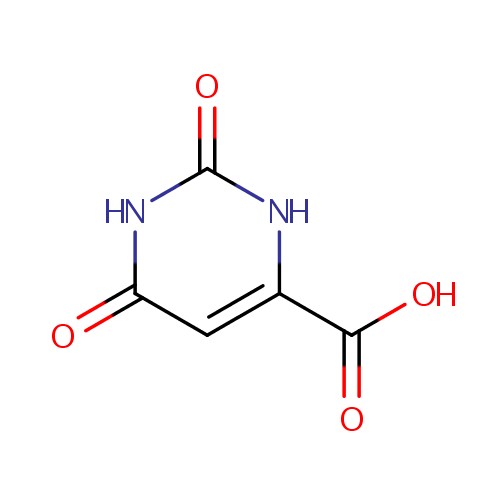
Orotic acid (PAMDB000094)
| Record Information | |||||||||||||||||||||||||||||||||||||||||||||||||||||||||||||
|---|---|---|---|---|---|---|---|---|---|---|---|---|---|---|---|---|---|---|---|---|---|---|---|---|---|---|---|---|---|---|---|---|---|---|---|---|---|---|---|---|---|---|---|---|---|---|---|---|---|---|---|---|---|---|---|---|---|---|---|---|---|
| Version | 1.0 | ||||||||||||||||||||||||||||||||||||||||||||||||||||||||||||
| Update Date | 1/22/2018 11:54:54 AM | ||||||||||||||||||||||||||||||||||||||||||||||||||||||||||||
| Metabolite ID | PAMDB000094 | ||||||||||||||||||||||||||||||||||||||||||||||||||||||||||||
| Identification | |||||||||||||||||||||||||||||||||||||||||||||||||||||||||||||
| Name: | Orotic acid | ||||||||||||||||||||||||||||||||||||||||||||||||||||||||||||
| Description: | Orotic acid is a heterocyclic compound and an acid; it is also known as pyrimidinecarboxylic acid. It was once believed to be part of the vitamin B complex and was called vitamin B13, but it is now known that it is not a vitamin but is instead manufactured in the body by intestinal flora. Orotic acid is converted to UMP by UMP synthase, a multifunctional protein with both orotate phosphoribosyltransferase and orotidylate decarboxylase activity. (Wikipedia) | ||||||||||||||||||||||||||||||||||||||||||||||||||||||||||||
| Structure | |||||||||||||||||||||||||||||||||||||||||||||||||||||||||||||
| Synonyms: |
| ||||||||||||||||||||||||||||||||||||||||||||||||||||||||||||
| Chemical Formula: | C5H4N2O4 | ||||||||||||||||||||||||||||||||||||||||||||||||||||||||||||
| Average Molecular Weight: | 156.0963 | ||||||||||||||||||||||||||||||||||||||||||||||||||||||||||||
| Monoisotopic Molecular Weight: | 156.017106626 | ||||||||||||||||||||||||||||||||||||||||||||||||||||||||||||
| InChI Key: | PXQPEWDEAKTCGB-UHFFFAOYSA-N | ||||||||||||||||||||||||||||||||||||||||||||||||||||||||||||
| InChI: | InChI=1S/C5H4N2O4/c8-3-1-2(4(9)10)6-5(11)7-3/h1H,(H,9,10)(H2,6,7,8,11) | ||||||||||||||||||||||||||||||||||||||||||||||||||||||||||||
| CAS number: | 65-86-1 | ||||||||||||||||||||||||||||||||||||||||||||||||||||||||||||
| IUPAC Name: | 2,6-dioxo-1,2,3,6-tetrahydropyrimidine-4-carboxylic acid | ||||||||||||||||||||||||||||||||||||||||||||||||||||||||||||
| Traditional IUPAC Name: | orotic acid | ||||||||||||||||||||||||||||||||||||||||||||||||||||||||||||
| SMILES: | OC(=O)C1=CC(=O)NC(=O)N1 | ||||||||||||||||||||||||||||||||||||||||||||||||||||||||||||
| Chemical Taxonomy | |||||||||||||||||||||||||||||||||||||||||||||||||||||||||||||
| Taxonomy Description | This compound belongs to the class of organic compounds known as pyrimidinecarboxylic acids. These are pyrimidines with a structure containing a carboxyl group attached to the pyrimidine ring. | ||||||||||||||||||||||||||||||||||||||||||||||||||||||||||||
| Kingdom | Organic compounds | ||||||||||||||||||||||||||||||||||||||||||||||||||||||||||||
| Super Class | Organoheterocyclic compounds | ||||||||||||||||||||||||||||||||||||||||||||||||||||||||||||
| Class | Diazines | ||||||||||||||||||||||||||||||||||||||||||||||||||||||||||||
| Sub Class | Pyrimidines and pyrimidine derivatives | ||||||||||||||||||||||||||||||||||||||||||||||||||||||||||||
| Direct Parent | Pyrimidinecarboxylic acids | ||||||||||||||||||||||||||||||||||||||||||||||||||||||||||||
| Alternative Parents | |||||||||||||||||||||||||||||||||||||||||||||||||||||||||||||
| Substituents |
| ||||||||||||||||||||||||||||||||||||||||||||||||||||||||||||
| Molecular Framework | Aromatic heteromonocyclic compounds | ||||||||||||||||||||||||||||||||||||||||||||||||||||||||||||
| External Descriptors |
| ||||||||||||||||||||||||||||||||||||||||||||||||||||||||||||
| Physical Properties | |||||||||||||||||||||||||||||||||||||||||||||||||||||||||||||
| State: | Solid | ||||||||||||||||||||||||||||||||||||||||||||||||||||||||||||
| Charge: | -1 | ||||||||||||||||||||||||||||||||||||||||||||||||||||||||||||
| Melting point: | 345.5 °C | ||||||||||||||||||||||||||||||||||||||||||||||||||||||||||||
| Experimental Properties: |
| ||||||||||||||||||||||||||||||||||||||||||||||||||||||||||||
| Predicted Properties |
| ||||||||||||||||||||||||||||||||||||||||||||||||||||||||||||
| Biological Properties | |||||||||||||||||||||||||||||||||||||||||||||||||||||||||||||
| Cellular Locations: | Cytoplasm | ||||||||||||||||||||||||||||||||||||||||||||||||||||||||||||
| Reactions: | 4,5-Dihydroorotic acid + Ubiquinone-8 > Orotic acid + Ubiquinol-8 4,5-Dihydroorotic acid + Menaquinone 8 > Menaquinol 8 + Orotic acid Orotidylic acid + Pyrophosphate <> Orotic acid + Phosphoribosyl pyrophosphate 4,5-Dihydroorotic acid + Fumaric acid <> Orotic acid + Succinic acid 4,5-Dihydroorotic acid + a ubiquinone > Orotic acid + a ubiquinol 4,5-Dihydroorotic acid + a menaquinone > Orotic acid + a menaquinol 4,5-Dihydroorotic acid + Quinone <> Orotic acid + Hydroquinone 4,5-Dihydroorotic acid + Ubiquinone-1 + 4,5-Dihydroorotic acid > Ubiquinol-1 + Orotic acid Orotic acid + Phosphoribosyl pyrophosphate > Pyrophosphate + Orotidylic acid | ||||||||||||||||||||||||||||||||||||||||||||||||||||||||||||
| Pathways: | |||||||||||||||||||||||||||||||||||||||||||||||||||||||||||||
| Spectra | |||||||||||||||||||||||||||||||||||||||||||||||||||||||||||||
| Spectra: | |||||||||||||||||||||||||||||||||||||||||||||||||||||||||||||
| References | |||||||||||||||||||||||||||||||||||||||||||||||||||||||||||||
| References: |
| ||||||||||||||||||||||||||||||||||||||||||||||||||||||||||||
| Synthesis Reference: | Mitchell, Herschel K.; Nyc, Joseph F. Intermediates in the synthesis of orotic acid from oxalacetic ester and urea. Journal of the American Chemical Society (1947), 69 674-7. | ||||||||||||||||||||||||||||||||||||||||||||||||||||||||||||
| Material Safety Data Sheet (MSDS) | Download (PDF) | ||||||||||||||||||||||||||||||||||||||||||||||||||||||||||||
| Links | |||||||||||||||||||||||||||||||||||||||||||||||||||||||||||||
| External Links: |
| ||||||||||||||||||||||||||||||||||||||||||||||||||||||||||||
Enzymes
- General function:
- Involved in catalytic activity
- Specific function:
- (S)-dihydroorotate + a quinone = orotate + a quinol
- Gene Name:
- pyrD
- Locus Tag:
- PA3050
- Molecular weight:
- 36.1 kDa
Reactions
| (S)-dihydroorotate + a quinone = orotate + a quinol. |
- General function:
- Involved in orotate phosphoribosyltransferase activity
- Specific function:
- Catalyzes the transfer of a ribosyl phosphate group from 5-phosphoribose 1-diphosphate to orotate, leading to the formation of orotidine monophosphate (OMP)
- Gene Name:
- pyrE
- Locus Tag:
- PA5331
- Molecular weight:
- 23.3 kDa
Reactions
| Orotidine 5'-phosphate + diphosphate = orotate + 5-phospho-alpha-D-ribose 1-diphosphate. |
Transporters
- General function:
- Involved in symporter activity
- Specific function:
- Responsible for the aerobic transport of the dicarboxylates fumarate, L- and D-malate and to a lesser extent succinate, from the periplasm across the inner membrane
- Gene Name:
- dctA
- Locus Tag:
- PA1183
- Molecular weight:
- 46 kDa

